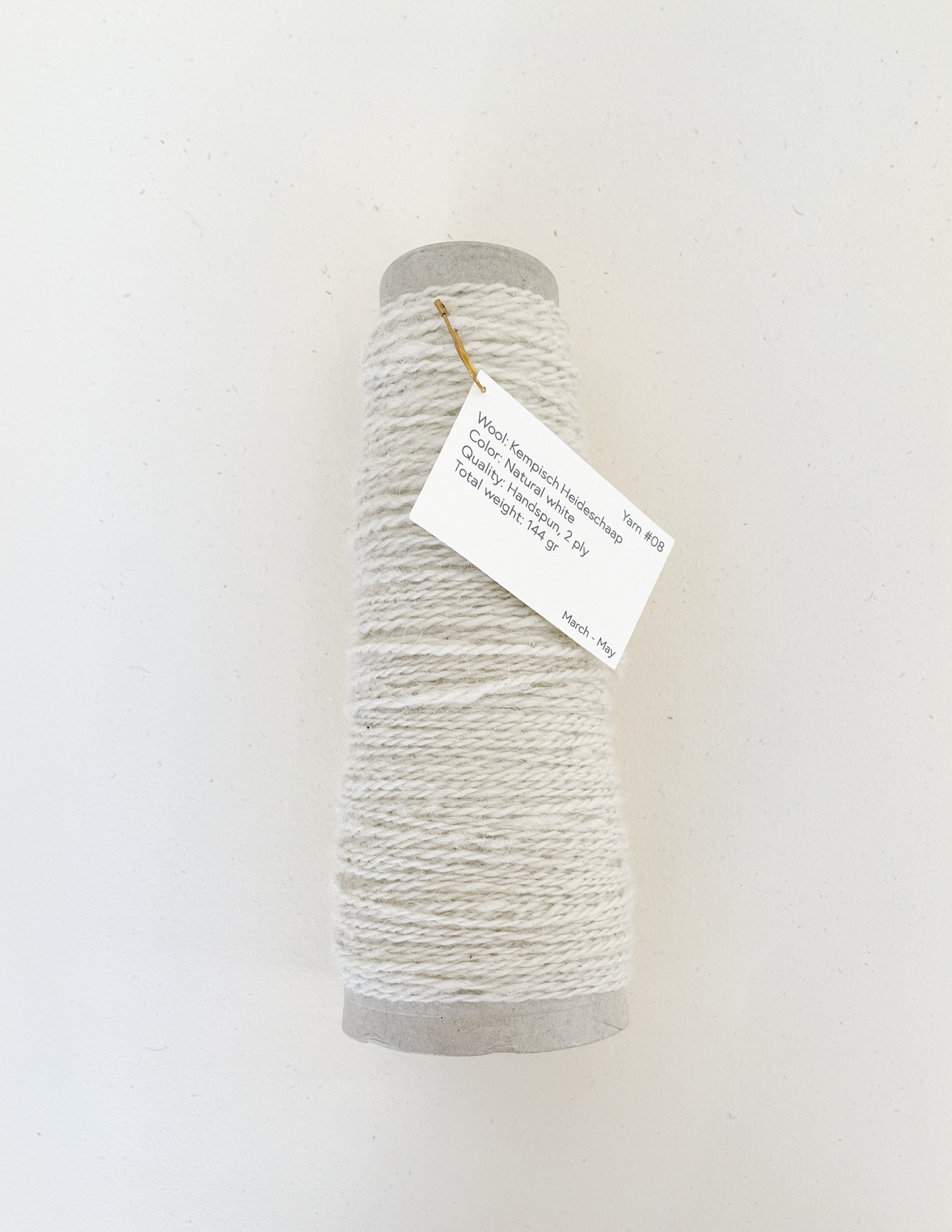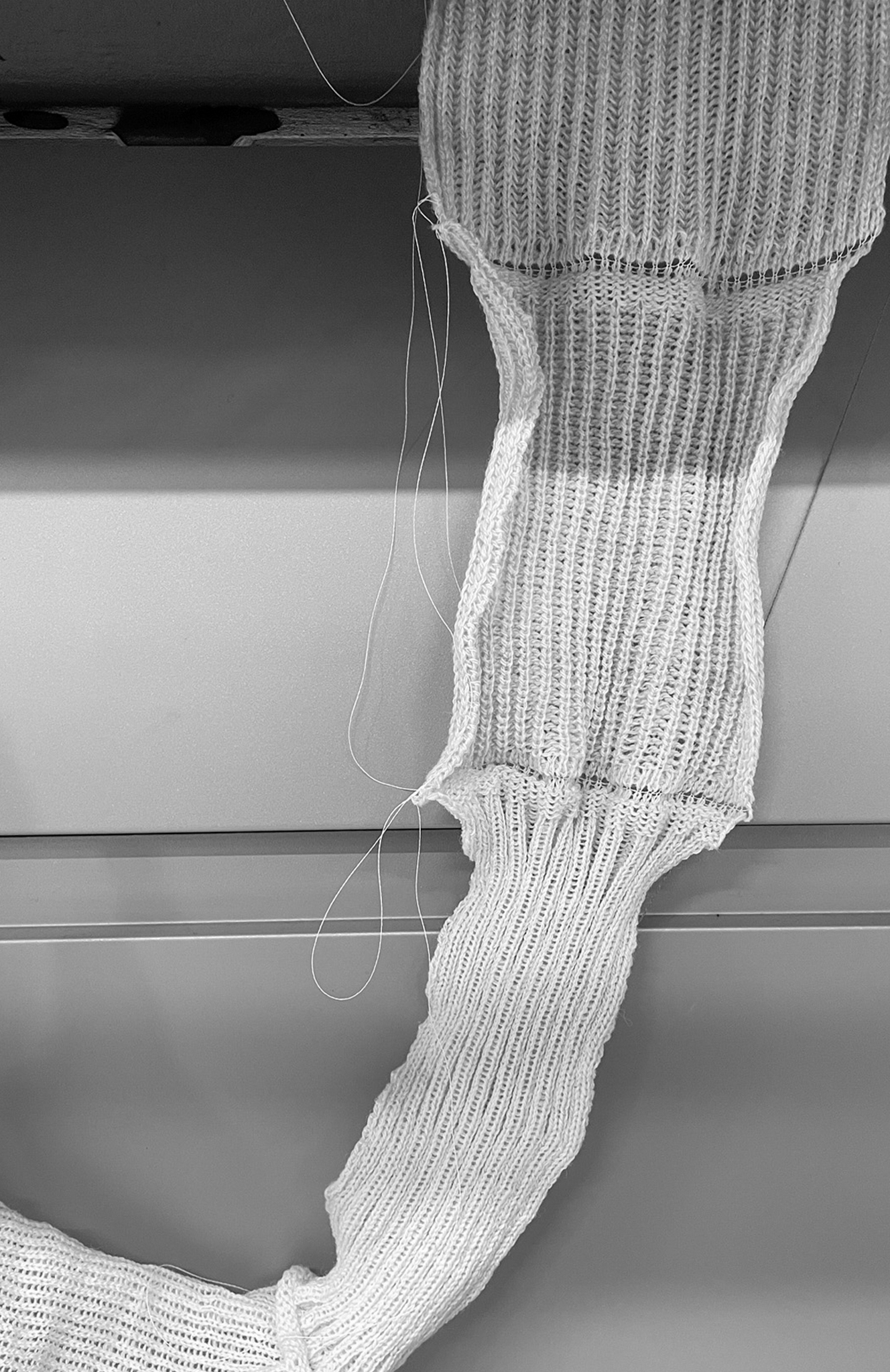What Matters
Reconstructing a locally produced jumper from different perspectives
The project includes a research paper, handspun and semi-mechanized yarns, knitted samples, a jumper, and a book of fieldwork and expert insights.
Thank you: Helle Graabæk, Louise Ravnløkke, Tineke Camps, Sjraar van Beek, Ina van Opstal, Roua Alhalabi, New Order of Fashion Lab (Eindhoven), and KnitwearLab (Almere).
MA Graduation project - Kolding school of Design (DK)
Year: 2024
Images flock & shearing : Peelkudde Schaapsdrift


Rooted in De Peel, the region of my childhood in the Netherlands, known for its rich history in wool trade, this project delves into its heritage while addressing the challenges posed by modern mass production. The landscape’s symbiotic relationship with sheep carries profound ecological, cultural, and emotional value. Due to industrialisation, however, the decline of wool sorting practices and expertise in fibre microns has diminished both the quality and utility of the wool. Yet, the Kempisch Heath Sheep, vital for preserving the heathland, continue to play a key role in maintaining these ecosystems, making their wool a sustainable by-product with a minimal ecological footprint.












The project combines hands-on material research, fieldwork, and collaboration with experts. This approach addresses the decline of small-scale production and the loss of tacit knowledge. By prioritising quality over quantity, craft not only reconnects people to local ecosystems but also promotes an environmentally responsible worldview. It addresses societal and environmental challenges by preserving and passing on important values and infusing our lives with meaning and purpose (Walker & Zhan, 2019). Instead of rejecting modernity, this method offers a creative framework that bridges traditional knowledge with contemporary needs, ultimately shaping our future and redefining the role of design in society.



Fieldwork and collaboration throughout the process, emphasised the need for region-specific production methods. Collaborating closely with experts who possess tacit knowledge, in ecology, shepherding, spinning, natural dye and knitting emphasises wool’s holistic value and ensures respect for its qualities throughout the process. ”This local, collaborative approach integrates place-specific resources and interactions, adapting materials and skills to reflect what is meaningful in a specific area (Fletcher & Tham, 2019).”






Handspun yarns, created in collaboration with master spinner Ina van Opstal, challenge the norms of standardised production by embracing natural variations in colour and design. The project prioritises transparency in textile creation, valuing craft for its ecological, local, and systemic importance. These yarns serve as a tactile medium of communication, reflecting their origins, by incorporating context, aiming for longevity that stems from uniqueness and emotional connection to something one of a kind. This narrative approach underscores the dynamic, relational nature of materials woven into our everyday lives.




In the process, a combination of manual and semi-mechanised methods has been adopted, embracing a natural rhythm and fostering collaborative solutions. Additionally, a compact HILO spinning machine was constructed, for home use. Built using laser-cut wood and basic tools, the machine exemplifies small-scale, open source manufacturing.












Using the larger HILO spinning machine in the NOoF LAB requires patience, as it spins yarn at one metre per minute, creating a texture similar to handspun yarn. While still a work in progress, the machine is complex and depends on pre-processed fibers, known as slivers, to function. Despite its current limitations, experimenting with semi-mechanised spinning offers valuable insights into fiber qualities and the possibilities of small-scale, local yarn production.












Knit
To explore their potential, self-made yarns were tested on a digital knitting machine at the KnitwearLab. The approach was to embraces limitations as creative frameworks rather than obstacles, encouraging creativity within constraints and promoting more mindful resource use. Additionally, a jumper was hand-knitted from the same yarns, serving as a prototype for future reflection on the quality, tactility, aesthetics, and overall value of the project.
To explore their potential, self-made yarns were tested on a digital knitting machine at the KnitwearLab. The approach was to embraces limitations as creative frameworks rather than obstacles, encouraging creativity within constraints and promoting more mindful resource use. Additionally, a jumper was hand-knitted from the same yarns, serving as a prototype for future reflection on the quality, tactility, aesthetics, and overall value of the project.
The project combines hands-on material research, fieldwork, and collaboration with experts. This approach addresses the decline of small-scale production and the loss of tacit knowledge. By prioritising quality over quantity, craft not only reconnects people to local ecosystems but also promotes an environmentally responsible worldview. It addresses societal and environmental challenges by preserving and passing on important values and infusing our lives with meaning and purpose (Walker & Zhan, 2019). Instead of rejecting modernity, this method offers a creative framework that bridges traditional knowledge with contemporary needs, ultimately shaping our future and redefining the role of design in society.




Handspun yarns, created in collaboration with master spinner Ina van Opstal, challenge the norms of standardised production by embracing natural variations in colour and design. The project prioritises transparency in textile creation, valuing craft for its ecological, local, and systemic importance. These yarns serve as a tactile medium of communication, reflecting their origins, by incorporating context, aiming for longevity that stems from uniqueness and emotional connection to something one of a kind. This narrative approach underscores the dynamic, relational nature of materials woven into our everyday lives.





Using the larger HILO spinning machine in the NOoF LAB requires patience, as it spins yarn at one metre per minute, creating a texture similar to handspun yarn. While still a work in progress, the machine is complex and depends on pre-processed fibres, known as slivers, to function. Despite its current limitations, experimenting with semi-mechanised spinning offers valuable insights into fiber qualities and the possibilities of small-scale, local yarn production.

To explore their potential, self-made yarns were tested on a digital knitting machine at the KnitwearLab. The approach was to embrace limitations as creative frameworks rather than obstacles, encouraging creativity within constraints and promoting more mindful resource use. Additionally, a jumper was hand-knitted from the same yarns, serving as a prototype for future reflection on the quality, tactility, aesthetics, and overall value of the project.
*Albers, A. (2001). Selected writings on Design.
*Fletcher, K., & Tham, M. (2019). Earth Logic: Fashion Action Research Plan.
*Krogh, M. (2020). Connectedness: an incomplete encyclopedia of Anthropocene: views, thoughts, considerations, insights, images, notes & remarks.
*Walker, S., & Zhan, X. (2019). Craft as leverage for Sustainable Design Transformation: A theoretical Foundation. The Design Journal. Routledge.